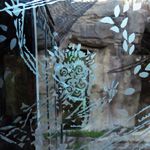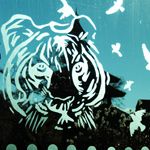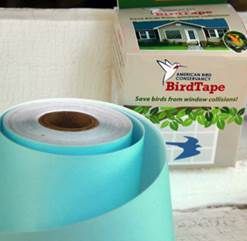
Publisher:
Bonnie King
CONTACT:
Newsroom@Salem-news.com
Advertising:
Adsales@Salem-news.com

~Truth~
~Justice~
~Peace~
TJP
Nov-21-2013 15:51

 TweetFollow @OregonNews
TweetFollow @OregonNews
Stunning Creativity by Virginia Artists Saving Birds at the Virginia Zoo
Salem-News.comCollisions Prevented by Innovative Use of ABC BirdTape...
 Courtesy: ABC Birds |
(WASHINGTON, DC) - Three artists from Virginia have taken a very practical product called ABC BirdTape, which is designed to prevent birds from fatally crashing into buildings or home windows, and turned it into spectacular artwork at the Virginia Zoo that maintains its functionality but brings breathtaking imagery to the task.
The three volunteer artists—Jacqueline Ehle Inglefield, Lizz Klaras, and Molly Lombard—were selected for the project and created unique works of art using BirdTape at the zoo's tiger pool and otter-gibbon viewing areas.
The tape is produced by American Bird Conservancy (ABC), one of the leading bird conservation groups in the United States, and was installed at the Norfolk, Va., zoo by the artists over two to three days.
“Without question, one of the most significant causes of bird mortality worldwide is bird collisions with glass, and the toll is probably escalating every year,” said Dr. Christine Sheppard, Bird Collisions Campaign Manager for ABC and one of the world’s leading experts on the issue.
Click on thumbnails for larger photos | |
Art by Jacqueline Ehle | Art by Molly Lombard at the Virginia Zoo's tiger pool
|
"Conservation is one of our core missions, so we wanted to learn how ABC BirdTape might help prevent bird strikes, but we also wanted something visitors would find visually stimulating, so they might want to learn more about protecting birds at home," said the zoo's executive director, Greg Bockheim.
Sheppard says that between 300 million and one billion birds die each year from collisions with glass in the United States. Some of the species that seem to be most affected are the Wood Thrush, Common Yellowthroat, Black-and-white Warbler, Dark-eyed Junco, White-throated Sparrow, Ruby-throated Hummingbird, and American Woodcock. The highest toll is in the fall and spring migration seasons, when birds are traveling great distances through unfamiliar territory. What makes matters worse, Sheppard says, is that nighttime lighting in cities actually attracts birds to dangerous urban environments.
“Parts of this problem are very simple to understand. For example, cues like window frames and even dirt tell people where to expect glass. Birds don’t learn these cues and so they take reflections literally or try to fly through transparent glass to reach something beyond it,” according to Sheppard.
The Virginia Zoo has been working with Old Dominion University (ODU) to study how different patterns of bird tape can affect bird strikes on large windows. As an additional project, Bockheim wanted to see how the bird tape might be used to create art.
Visitors can see the bird tape art, along with patterns from the ODU study, now through the end of November. All the tape will be removed at the end of the month, when the ODU study and the migration period of the subject bird species, the Yellow-rumped Warbler, ends.
Progress in Preventing Bird Collisions
While progress identifying and producing bird-friendly glass is slowly advancing, there are also reasons for optimism. The state of Minnesota and the city of Oakland, Calif., are the latest in a string of governments to approve bird-friendly building design requirements. Oakland has adopted requirements similar to those established in neighboring San Francisco in 2011, while Minnesota followed the framework in LEED’s (Leadership in Engineering and Environmental Design) pilot credit for “Reducing Bird Collisions.” In Illinois, several jurisdictions—Cook County, Highland Park, Lake County, and Evansville—have existing or pending guidelines, and California’s Green Building Standards Code encourages voluntary application of bird-friendly design practices. Meanwhile, national legislation to reduce bird collisions in federal buildings has been proposed in the U.S. Congress.
“We are seeing increasing interest in and awareness of this issue among governments, architects, and developers,” says Sheppard. As evidence, bird collisions was featured on the cover of the Sept. 21, 2013, issue of the journal Science News.
Sheppard worked extensively with officials in San Francisco, along with Noreen Weeden from Golden Gate Audubon, to develop that city’s bird-friendly requirements. She also has been presenting continuing education classes on the issue to architecture firms across the country upon request, and authored the only national publication on the issue: American Bird Conservancy’s Bird-Friendly Building Design.
Tips to Reduce Bird Collisions
Most birds will avoid windows with vertical stripes spaced four inches apart, or horizontal stripes spaced two inches apart. More complicated or irregular patterns will also work as long as they follow those general guidelines. For best results, patterns must be on the outside surface of the windows.
|
ABC BirdTape out of the box |
As the story above points out, you can use ABC BirdTape to create patterns. Although any opaque tape can work, ABC BirdTape transmits light and is made to last outdoors. Most window films designed for external use are not patterned and will not deter birds. However, interior window films come in many colors and styles, and can be applied on the outside of windows to prevent collisions.
If you don’t want to alter the glass itself, you can stretch lightweight netting, screen, or other material over the window. The netting must be several inches in front of the window, so birds don’t hit the glass after hitting the net. Several companies sell screens, solar shades, or other barriers that can be attached with suction cups or eye hooks.
Prefabricated decals can work if spaced properly. The shape does not matter; birds see decals shaped like raptors as obstacles but not as predators. To be effective, decals must be spaced no more than four inches apart horizontally or two inches apart vertically—more closely than recommended by most manufacturers.
More information about ABC BirdTape can be found at abcbirdtape.org. More information about the participating artists is available at jackieehle.com, lizzklaras.showitsite.com and mollylombardart.com. Learn more about the Virginia Zoo at virginiazoo.org.
ABC BirdTape is produced with the generous support of the Rusinow Family Foundation.
American Bird Conservancy (ABC) is a 501(c)(3) not-for-profit membership organization whose mission is to conserve native birds and their habitats throughout the Americas. ABC acts by safeguarding the rarest species, conserving and restoring habitats, and reducing threats, while building capacity in the bird conservation movement.
 |
 |
 |
Articles for November 20, 2013 | Articles for November 21, 2013 | Articles for November 22, 2013
Quick Links
DINING
Willamette UniversityGoudy Commons Cafe
Dine on the Queen
Willamette Queen Sternwheeler
MUST SEE SALEM
Oregon Capitol ToursCapitol History Gateway
Willamette River Ride
Willamette Queen Sternwheeler
Historic Home Tours:
Deepwood Museum
The Bush House
Gaiety Hollow Garden
AUCTIONS - APPRAISALS
Auction Masters & AppraisalsCONSTRUCTION SERVICES
Roofing and ContractingSheridan, Ore.
ONLINE SHOPPING
Special Occasion DressesAdvertise with Salem-News
Contact:AdSales@Salem-News.com


Salem-News.com:


Terms of Service | Privacy Policy



All comments and messages are approved by people and self promotional links or unacceptable comments are denied.
[Return to Top]
©2026 Salem-News.com. All opinions expressed in this article are those of the author and do not necessarily reflect those of Salem-News.com.